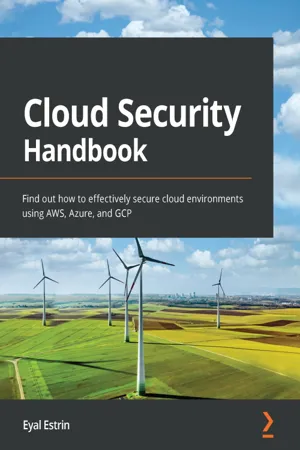
Cloud Security Handbook
Eyal Estrin
- 456 páginas
- English
- ePUB (apto para móviles)
- Disponible en iOS y Android
Cloud Security Handbook
Eyal Estrin
Información del libro
A comprehensive reference guide to securing the basic building blocks of cloud services, with actual examples for leveraging Azure, AWS, and GCP built-in services and capabilitiesKey Features• Discover practical techniques for implementing cloud security• Learn how to secure your data and core cloud infrastructure to suit your business needs• Implement encryption, detect cloud threats and misconfiguration, and achieve compliance in the cloudBook DescriptionSecuring resources in the cloud is challenging, given that each provider has different mechanisms and processes. Cloud Security Handbook helps you to understand how to embed security best practices in each of the infrastructure building blocks that exist in public clouds.This book will enable information security and cloud engineers to recognize the risks involved in public cloud and find out how to implement security controls as they design, build, and maintain environments in the cloud. You'll begin by learning about the shared responsibility model, cloud service models, and cloud deployment models, before getting to grips with the fundamentals of compute, storage, networking, identity management, encryption, and more. Next, you'll explore common threats and discover how to stay in compliance in cloud environments. As you make progress, you'll implement security in small-scale cloud environments through to production-ready large-scale environments, including hybrid clouds and multi-cloud environments. This book not only focuses on cloud services in general, but it also provides actual examples for using AWS, Azure, and GCP built-in services and capabilities.By the end of this cloud security book, you'll have gained a solid understanding of how to implement security in cloud environments effectively.What you will learn• Secure compute, storage, and networking services in the cloud• Get to grips with identity management in the cloud• Audit and monitor cloud services from a security point of view• Identify common threats and implement encryption solutions in cloud services• Maintain security and compliance in the cloud• Implement security in hybrid and multi-cloud environments• Design and maintain security in a large-scale cloud environmentWho this book is forThis book is for IT or information security personnel taking their first steps in the public cloud or migrating existing environments to the cloud. Cloud engineers, cloud architects, or cloud security professionals maintaining production environments in the cloud will also benefit from this book. Prior experience of deploying virtual machines, using storage services, and networking will help you to get the most out of this book.
Preguntas frecuentes
Información
Section 1: Securing Infrastructure Cloud Services
- Chapter 1, Introduction to Cloud Security
- Chapter 2, Securing Compute Services
- Chapter 3, Securing Storage Services
- Chapter 4, Securing Network Services
Chapter 1: Introduction to Cloud Security
- Netflix – one of the largest video streaming services world-wide. It uses AWS to run its media streaming services:
- Mercedes-Benz – one of the most famous automotive brands. It uses Azure to run its research and development:
- Home Depot – the largest home improvement retailer in the United States. It uses Google Cloud to run its online stores:
- Why we need security
- Cloud service models
- Cloud deployment models
- The shared responsibility model
Technical requirements
What is a cloud service?
- On-demand self-service: Imagine you wish to open a blog and you need compute resources. Instead of purchasing hardware and waiting for the vendor to ship it to your office and having to deploy software, the easier alternative can be a self-service portal, where you can select a pre-installed operating system and content management system that you can deploy within a few minutes by yourself.
- Broad network access: Consider having enough network access (the type that large Internet Service Providers (ISPs) have) to serve millions of end users with your application.
- Resource pooling: Consider having thousands of computers, running in a large server farm, and being able to maximize their use (from CPU, memory, and storage capacity), instead of having a single server running 10% of its CPU utilization.
- Rapid elasticity: Consider having the ability to increase and decrease the amount of compute resources (from a single server to thousands of servers, and then back to a single server), all according to your application or service needs.
- Measured service: Consider having the ability to pay for only the resources you consumed and being able to generate a billing report that shows which resources have been used and how much you must pay for the resources.
What are the cloud deployment models?
- Private cloud: An infrastructure deployed and maintained by a single organization. Let's say we are a large financial organization (such as a bank or insurance organization), we would like to serve various departments in our organization (from HR, IT, sales, and so on), and w...